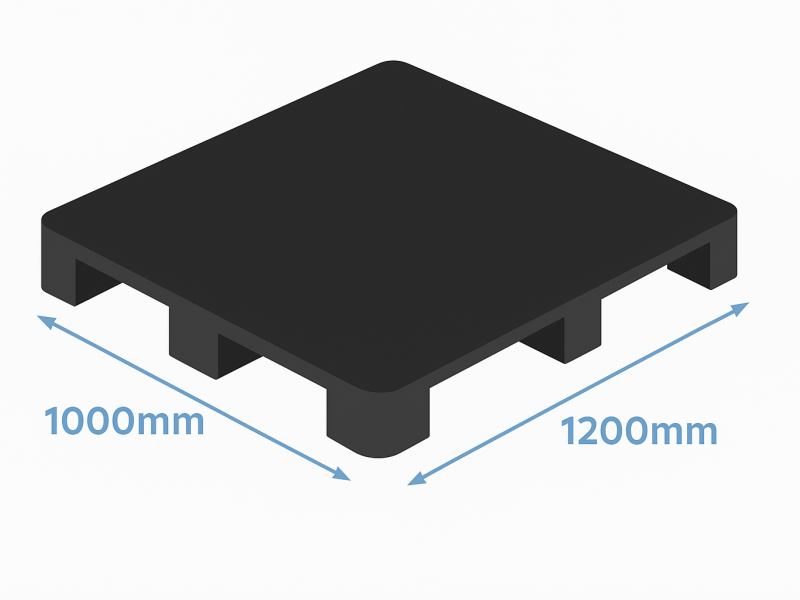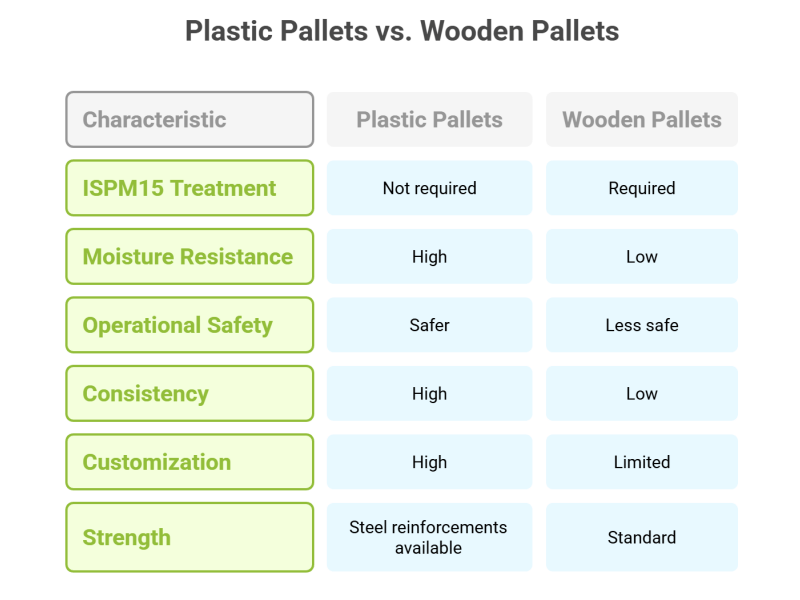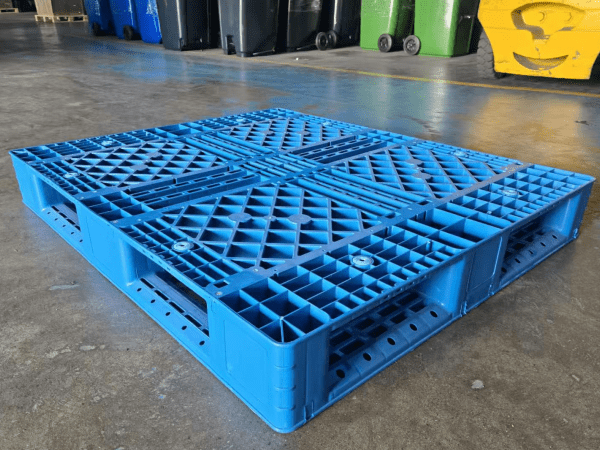Ever had a pallet that almost fit the truck—until it didn’t? Or watched a perfect stack get rejected by a UK warehouse scanner? You’re not alone. In UK logistics, a few millimeters can mean failed automation, wasted freight space, or full-load rework. This isn’t just about “knowing the size”—it’s about understanding how pallet standards impact load planning, racking, and export compliance. Whether you’re shipping bottled water, pharma boxes, or stacked bulk bins, this guide walks you through the UK pallet logic like someone who’s actually dealt with it.
What Is the Standard Pallet Size in the UK?
The UK standard pallet measures 1200mm x 1000mm, or 47.2 x 39.4 inches. This is the dominant pallet footprint in domestic supply chains. You’ll find it widely used for both wooden and plastic pallets UK across industrial and retail sectors. This size fits well with UK-standard truck beds, racking systems, and storage zones.

UK vs Euro Pallet Size: What’s the Real Difference?
A Euro pallet is 1200mm x 800mm, which makes it 200mm narrower. This matters more than you think—it can affect container fill rates, forklift compatibility, and shelf usage. If you’re comparing UK vs Euro pallet size, always factor in where your goods are going and how they’ll be handled along the way.
When to Choose the UK Size Over Euro
If your operations are mainly within the UK, especially in local warehousing or retail delivery, the 1200x1000mm footprint is usually a better fit. It’s more stable for wider product loads and works well with UK-standard racking and truck dimensions. Many plastic pallets UK manufacturers, including us, design this as a default size for domestic and near-shore use.
But when selecting a pallet, don’t just look at surface size. The dimensions of a pallet include both the base and how it interacts with stacking, loading equipment, and packaging formats. That’s why UK logistics companies often standardize around this specific pallet size—it simplifies inventory movement and minimizes rework.
Keep in mind: while the Euro pallet is more widely accepted across continental Europe, the UK size offers better load efficiency for large plastic pallets, especially when you’re shipping mixed or irregular goods.
What Are the Common UK Pallet Height Options?
In UK logistics, pallet height means the full load height, not just the base. This affects racking, stacking, and trailer space. Staying within standard height zones helps avoid extra costs and improves handling speed.
Typical pallet height categories include:
- Full Pallet: ~2200mm
- Half Pallet: ~1200mm
- Quarter Pallet: ~800mm
- Micro Pallet: ~600mm
These categories match standard forklift limits and trailer dimensions. Exceeding them can cause issues in scanning, racking, or warehouse automation.
Be aware: tail lifts, mezzanine floors, and ASRS often have strict height limits. Even a small oversize may trigger rejection or delays. Always verify the height fit before shipping.
What’s the Maximum Weight Capacity for Each UK Pallet Type?
Weight capacity isn’t only about dimensions of a pallet—it’s about how the load behaves under real handling. Even a UK standard plastic pallet can perform differently depending on whether it’s used on the floor, stacked, or placed in a high-bay racking system.
Here’s a reference range for common pallet types (with evenly distributed loads):
- Full Pallet: 1000–1200 kg
- Half Pallet: around 500 kg
- Quarter Pallet: around 250 kg
Using plastic pallets for heavy or high-density products? Be cautious—stacking increases pressure, and rack loading introduces flex stress. In these cases, heavy duty plastic pallets UK buyers prefer are often fitted with steel tubes for enhanced support and reduced deflection.
If you’re unsure, don’t just measure your boxes—match the load to the pallet’s structural build. It’s the only way to avoid costly rework, especially in automated or high-risk storage systems.
UK Pallet Sizes vs Global Standards: How Compatible Are They?
If you’re exporting or coordinating international supply chains, understanding size compatibility matters far more than just checking pallet length and width. Below is a side-by-side comparison of major pallet standards:
| Pallet Standard | Size (mm) | Common Regions | Container Fit | Racking Compatibility | Typical Industry Use | Plastic Pallet Availability |
|---|---|---|---|---|---|---|
| UK Standard | 1200 x 1000 | UK, Australia (partial), MEA | Fits 2 side-by-side in ISO containers | Strong (esp. with steel-reinforced base) | Retail delivery, industrial logistics | Widely available (esp. plastic pallets UK) |
| Euro (EUR1) | 1200 x 800 | Europe, parts of Africa | High fill rate in Euro trucks | Compatible with most EU racks | FMCG, pharma, EU warehouse automation | Yes (many plastic pallet sizes built on EUR1) |
| US Standard (GMA) | 1219 x 1016 (48"x40") | North America | Suboptimal in ISO containers | Rackable, but may overhang in EU setups | Grocery, wholesale distribution | Yes, though not native to UK standard plastic pallet systems |
| Asia Standard | 1100 x 1100 | Japan, Korea, SE Asia | Square shape wastes container space | Less ideal for narrow UK racking | Electronics, exports, domestic loops | Yes, but less common in UK networks |
Plastic pallets are especially useful when switching between zones. With the right base structure and sizing, one pallet SKU can meet both UK and international needs—saving cost and avoiding repacking delays.
If you’re exporting, make sure your plastic pallet fits both your warehouse racking and overseas container specs—some pallets won’t work in both without redesign.
Choosing the Right Pallet Size: Standard or Oversized?
Are your products too long, too heavy, or packed in unusual shapes? If so, standard pallet sizes may not give you the best results—especially when you’re dealing with high-value goods, fragile items, or custom packaging formats.
When deciding between a UK standard plastic pallet and something larger, ask yourself:
- Is your product footprint exceeding 1000x1200mm, even with tight packing? Oversized goods often create overhangs, which increase the risk of product damage.
- Do you need extra strength for concentrated loads? In some cases, larger pallets are built with steel-reinforced decks or thicker walls to handle point pressure.
- Is your freight charged by space or unit count? Sometimes, optimizing for more products per pallet—even using large plastic pallets—reduces your per-unit shipping cost.
Still, going oversized has trade-offs. It may cause issues in shared pallet pools, automation systems, or third-party warehouses. That’s why most companies default to plastic pallet sizes aligned with local standards unless there’s a clear business case for going beyond.
Need to balance unit cost, transport fit, and warehouse flow? Talk to your supplier about whether standard or export-ready custom pallets are the right choice for your operation.
Why Choose Plastic Pallets for UK Logistics?
Had issues with fumigation delays or moldy wooden pallets? You’re not alone. In UK logistics, plastic pallets are now widely used to avoid these problems.

Plastic pallets UK exporters rely on don’t need ISPM15 treatment. That means no fumigation, fewer customs checks, and faster cross-border shipping. Plastic is also moisture-resistant, making it ideal for food, pharma, and hygiene-sensitive industries.
Operationally, plastic pallets are safer and more consistent. You avoid splinters, nails, or weight variation. This helps with clean stacking, reliable loading, and full automation compatibility—especially in ASRS.
Need stronger support? Heavy duty plastic pallets UK suppliers offer versions with steel reinforcements for racking. Custom options like logos, RFID chips, or different deck types make plastic more flexible than wood.
Practical Applications: Industry Use Cases and Loading Efficiency
In bottled water distribution, using UK standard plastic pallets helps match your rack footprint exactly. Most water racks are designed for the 1200x1000mm size, so you can load without overhang or shifting during transport. When stacking layers, keep your pallet height within 2200mm to avoid rejection by automated warehouses or retail hubs.
| Industry Use Case | Recommended Pallet Type | Loading Efficiency Tips |
|---|---|---|
| Bottled Water Logistics | UK standard plastic pallet (1200×1000mm), open-deck or custom rack | Use 1200x1000mm racks for exact fit; stack up to 2200mm for retail or warehouse entry. |
| Export of Vegetables or Pharmaceuticals | Closed-deck plastic pallets UK, or collapsible pallet boxes on standard bases | Maintain hygiene, avoid carton sagging; optimize container fill by matching standard pallet footprint. |
| Industrial or Chemical Warehousing | Large plastic pallets with steel-reinforced runners | Prevent flexing under heavy point loads; test stacking stability before high-bay storage. |
UK Logistics Needs Standards—We Build Pallets That Match
UK logistics runs on precision—standard pallet sizes, defined load heights, and strict racking rules. If your pallet doesn’t match, your shipment slows down. That’s why standard-compliant plastic pallets are not optional—they’re strategic.
At Enlightening Pallet, we manufacture export-ready plastic pallets UK businesses trust—fully aligned to the 1200×1000mm UK standard. Durable, hygienic, rack-compatible, and ready for automated handling—we help you ship smarter and safer.
Talk to a Pallet Expert Today!
We’ll help you:
- Match pallet size to load, rack, and transport
- Customize deck type, steel reinforcements, or branding
- Ensure your pallet meets UK logistics and export standards
Send us your specs—we’ll deliver the solution.





